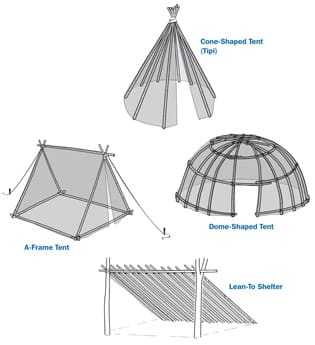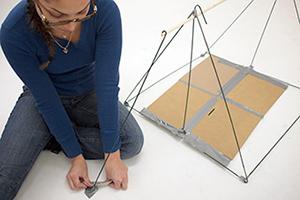Overview
Materials
Per Team:
- 2-4 cardboard sheets (about the size of copy paper)
- 16 5-ft (1.5-m) bamboo plant stakes (or another size, if unavailable)
- 3–4 large garbage bags, cut open into sheets
- scissors
- duct tape
- string
Instructions
DEFINE THE NEED
What is an emergency shelter? Who might need one—and why? People seeking shelter could include hikers, scouting or camping groups, homeless people, or people caught in a flood, hurricane, or other disaster.
 Can you think of any examples of people in your community who have needed emergency shelters? What was the situation and how did the shelter help them? Decide who you want to design your shelter for—and think of what kind of shelter would be best for them.
Can you think of any examples of people in your community who have needed emergency shelters? What was the situation and how did the shelter help them? Decide who you want to design your shelter for—and think of what kind of shelter would be best for them.
BRAINSTORM & DESIGN
It’s hard to design and build something this size on your own—find one or more people to help. Teamwork is an important part of engineering!
Your shelter must be sturdy and big enough to hold at least one person. Think about these questions:
- What features would make for a good shelter?
- What would be fairly speedy to build? Remember, this is an emergency!
- How will you make a sturdy frame?
- How will you connect the poles that make up the frame?
- How will you attach the cover to the frame?
- How will you get in and out of your shelter?
Then sketch your ideas for a shelter on a piece of paper.
BUILD, TEST, EVALUATE, & REDESIGN
Build your shelter. Then decide on a good way to test it.
- Does your structure have a solid base, are the materials strong enough, and are they securely fastened together?
- How can you make a wobbly frame more stable?
Guiding questions
WHAT IF …
- the frame collapses? Engineers and inventors understand the importance of building a solid foundation, or a stable base, for a tall structure to sit on. If the base is too small or if it is not well anchored (or tied down), the structure can tip over.
- it tilts or twists? One way to make a frame strong and to keep it from tilting or twisting is to connect each part to one or more other parts. Try placing one or more bamboo stakes at an angle between two parts of the frame. This creates a triangular brace, which makes the frame more rigid.
- the sheeting keeps slipping off? If the plastic cover slides off the frame, try taping two or three plastic sheets together before draping it over the frame. Once you have the cover in place, secure it with tape or string.
Engineering & science connections
 There are many reasons people might need temporary shelters. Natural disasters like hurricanes, earthquakes, floods, fires, and tornados are some of them. Millions of people around the globe have had their lives disrupted by these disasters. At one time, emergency shelters were flimsy tents; but today, engineers have come up with an amazing variety of high-tech designs that can be built quickly, easily, and cheaply so that people have a safe place to live.
There are many reasons people might need temporary shelters. Natural disasters like hurricanes, earthquakes, floods, fires, and tornados are some of them. Millions of people around the globe have had their lives disrupted by these disasters. At one time, emergency shelters were flimsy tents; but today, engineers have come up with an amazing variety of high-tech designs that can be built quickly, easily, and cheaply so that people have a safe place to live.- Engineers have also designed shelters for firefighters who have the dangerous job of battling wildfires. A fire shelter has an outer layer of special aluminum foil that helps reflect heat away from the shelter. Then there is another inner layer of foil with a layer of air in between to provide protection. In an emergency, all the firefighter has to do is grab two plastic handles and shake the shelter open—just like a pop-up tent. It’s saved the lives of hundreds of firefighters!
Major Funding is provided by the National Science Foundation. Project funding is provided by The Lemelson Foundation.
The DESIGN SQUAD GLOBAL material is based on work supported by the National Science Foundation under Grant No. DRL: 1422236. Any opinions, findings, and conclusions or recommendations expressed in this material are those of the author(s) and do not necessarily reflect the views of the National Science Foundation.


0 Comments